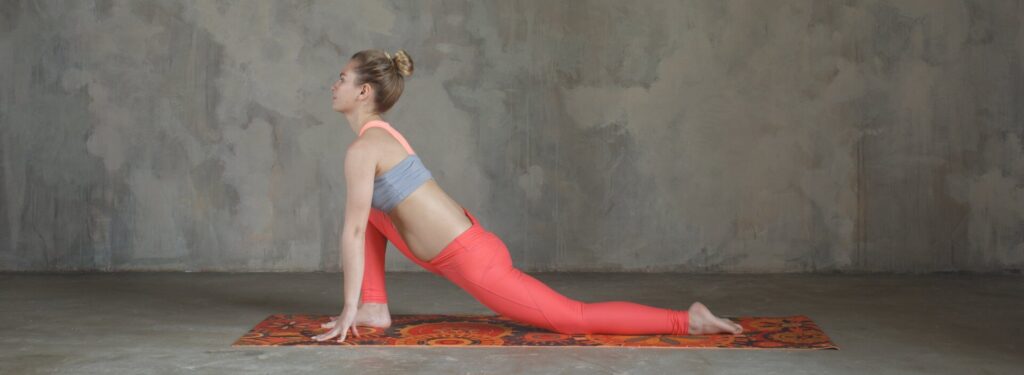“The lunge pose teaches us balance: one foot anchored in the past, the other reaching for the future.”
Step into the world of yoga with the foundational Lunge Pose (Utthita Ashwa Sanchalanasana), a beginner-friendly posture that stretches your hip flexors and strengthens your legs. Lunge Pose, also known as Utthita Ashwa Sanchalanasana in Sanskrit, is a fundamental yoga posture perfect for beginners. This pose helps improve balance, build leg strength, and increase flexibility in the hip flexors. In this article, we’ll explore the origin, benefits, and step-by-step instructions for practicing Lunge Pose.
Lunge Pose – Utthita Ashwa Sanchalanasana
Utthita Ashwa Sanchalanasana Meaning
The name “Utthita Ashwa Sanchalanasana” combines several Sanskrit words, with “Utthita” meaning “extended,” “Ashwa” meaning “horse,” and “Sanchalana” meaning “movement.” The pose reflects the shape of a horse’s leap, symbolizing power and grace.
Benefits of Lunge Pose
- Lunge Pose (Utthita Ashwa Sanchalanasana) offers a range of benefits for both the body and mind:
- Leg Strength: This pose strengthens the quadriceps, hamstrings, and calf muscles, enhancing lower body strength.
- Hip Flexor Stretch: It stretches the hip flexors, which can become tight due to prolonged sitting.
- Improved Balance: Lunge Pose challenges balance and stability, helping to develop a strong foundation for your yoga practice.
- Core Engagement: While practicing this pose, your core muscles are engaged to support the spine and pelvis.
- Mental Focus: Lunge Pose encourages concentration and mindfulness as you maintain balance.
Step-by-Step Instructions Lunge Pose

- Starting Position: Begin in a standing position at the front of your mat, with your feet hip-width apart and arms relaxed at your sides.
- Step Back: On an inhalation, take a step back with your right foot, extending it behind you. Keep the toes of your right foot tucked under.
- Low Lunge: Lower your hips toward the ground, bending your left knee at a 90-degree angle. Ensure your left knee is stacked directly above your left ankle.
- Back Leg: The back leg should be extended straight, with the right heel lifted off the mat. The toes of your right foot point forward.
- Torso Upright: Keep your upper body upright, with your chest open and shoulders relaxed. Engage your core for stability.
- Arms: Your arms can remain at your sides or reach upward overhead, palms facing each other.
- Hold and Breathe: Hold the pose for 30 seconds to one minute while breathing deeply and evenly.
- Switch Sides: To release, step your right foot forward to meet the left and return to a standing position. Then, repeat the same sequence on the other side.
Lunge Pose Variations and Modifications
If you find it challenging to balance, place your hands on your hips or use a wall or chair for support. To intensify the stretch in the hip flexors, lift your arms overhead while in the pose.
Tips for a Deeper Practice Lunge
Focus on sinking deeper into the lunge while keeping your hips square and aligned with your front knee. Engage your core muscles to protect your lower back and maintain balance. Experiment with different arm variations to find what feels most comfortable and enhances the stretch.
Preparation Poses
- Mountain Pose (Tadasana): Start your practice with Mountain Pose to center yourself and establish proper alignment.
- Forward Fold (Uttanasana): Uttanasana can help warm up the hamstrings and lower back, making it an excellent preparation for Lunge Pose.
Alternative Poses Lunge
- Child’s Pose (Balasana): After practicing Lunge Pose, relax in Child’s Pose to release tension and restore calmness.
- Downward-Facing Dog (Adho Mukha Svanasana): Downward Dog can help stretch and realign the spine after practicing standing poses.
Final Thoughts
Lunge Pose (Utthita Ashwa Sanchalanasana) is an essential yoga posture that introduces beginners to the practice of balance, strength, and flexibility. By regularly incorporating this pose into your yoga routine, you can strengthen your legs, improve hip flexibility, and develop a solid foundation for more advanced poses. Embrace the grace of a horse’s leap as you step into the world of yoga with Lunge Pose.


